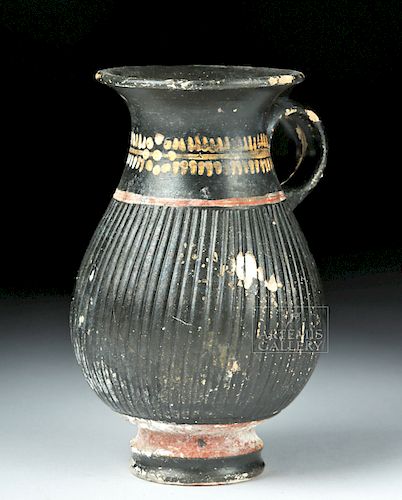Gnathian Pottery Thistle Mug w/ Painted Motifs
Lot 23
About Seller
Artemis Fine Arts
686 S Taylor Ave, Ste 106
Louisville, CO 80027
United States
Selling antiquities, ancient and ethnographic art online since 1993, Artemis Gallery specializes in Classical Antiquities (Egyptian, Greek, Roman, Near Eastern), Asian, Pre-Columbian, African / Tribal / Oceanographic art. Our extensive inventory includes pottery, stone, metal, wood, glass and textil...Read more
Estimate:
$500 - $750
Absentee vs Live bid
Two ways to bid:
- Leave a max absentee bid and the platform will bid on your behalf up to your maximum bid during the live auction.
- Bid live during the auction and your bids will be submitted real-time to the auctioneer.
Bid Increments
| Price | Bid Increment |
|---|---|
| $0 | $25 |
| $300 | $50 |
| $1,000 | $100 |
| $2,000 | $250 |
| $5,000 | $500 |
| $10,000 | $1,000 |
| $20,000 | $2,500 |
| $50,000 | $5,000 |
| $100,000 | $10,000 |
| $200,000 | $20,000 |
About Auction
By Artemis Fine Arts
Aug 2, 2018
Set Reminder
2018-08-02 10:00:00
2018-08-02 10:00:00
America/New_York
Bidsquare
Bidsquare : Antiquities | Egypt, Greece, Italy, Asia
https://www.bidsquare.com/auctions/artemis-gallery/antiquities-egypt-greece-italy-asia-3352
Featuring two incredible collections - one in storage for more than 20 years! Artemis Fine Arts info@artemisgallery.com
Featuring two incredible collections - one in storage for more than 20 years! Artemis Fine Arts info@artemisgallery.com
- Lot Description
Magna Graecia, Southern Italy, Eastern Apulia/Gnathia, ca. 370 to 325 BCE. A wheel-thrown thistle mug with a petite tiered foot, a bulbous body that tapers to a wide neck, a flared rim, and an applied bifurcated ring handle. The body is detailed with dozens of thin, pattern-molded ribs, red pigment along the foot and shoulder, and a yellow vine with densely-congregated berries wrapping from one side of the handle to the other. Scattered areas of faint silvery iridescence complement the black-glazed surfaces, making this a wonderful and attractive example of Gnathian craftsmanship! Size: 2.9" W x 4.75" H (7.4 cm x 12.1 cm).
Gnathia ware is named for the site where it was first discovered - the Apulian site of Egnathia. The black glaze ware is traditionally decorated with floral motifs in red, white, or yellow hues. Scholars believe that its production most likely was centered around Taras, with primary workshops in Egnathia and Canosa. The quantity and quality of Greek colonial Apulian potters increased significantly following the Peloponnesian War when Attic exports dramatically decreased. Apulian artistry demonstrates influences of Ionian (Athenian, Attic) conventions, as well as Doric (western colonial Greek) styles, with a palpable native Italian aesthetic.
Provenance: private East Coast, USA collection
All items legal to buy/sell under U.S. Statute covering cultural patrimony Code 2600, CHAPTER 14, and are guaranteed to be as described or your money back.
A Certificate of Authenticity will accompany all winning bids.
We ship worldwide and handle all shipping in-house for your convenience.
#135528Handle reattached with small chips and light adhesive residue along break lines. Surface wear and minor abrasions commensurate with age, small nicks and chips to rim, body, and foot, with fading to areas of glaze and pigmentation. Light earthen deposits throughout. Scattered areas of silvery iridescence. Old inventory sticker on bottom of foot.Condition
- Shipping Info
-
All shipping is handled in-house for your convenience. Your invoice from Artemis Gallery will include shipping calculation instructions. If in doubt, please inquire BEFORE bidding for estimated shipping costs for individual items.
-
- Buyer's Premium



 EUR
EUR CAD
CAD AUD
AUD GBP
GBP MXN
MXN HKD
HKD CNY
CNY MYR
MYR SEK
SEK SGD
SGD CHF
CHF THB
THB
















